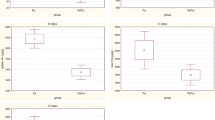Abstract
We have undertaken studies in humans and animals that aimed to obtain further information about the intake and excretion of boron (B) as well as its effects on markers of coronary heart disease. In humans, we have shown that the intake of B is 2.2 mg/d; its urinary excretion is 1.9 mg/d, and there appears to be little intraindividual variation. Supplementation with 10 mg of B/d resulted in the recovery of 84% of the dose in the urine and a significant increase in plasma estradiol concentration, but no effect on plasma lipoproteins. In rats, increasing the intake of B through the drinking water is reflected in the tissue concentrations, results in an increase in plasma testosterone and vitamin D, and results in a decrease in HDL cholesterol. It is clear that B has the potential to impact significantly on a number of metabolic processes.
Similar content being viewed by others
References
M. R. Naghii and S. Samman, The role of boron in nutrition and metabolism,Prog. Food Nutr. Sci. 17, 331–349 (1993).
L. Butterwick, N. de Oude, and K. Raymond, Safety assessment of boron in aquatic and terrestrial environments,Ecotoxicol. Environ. Safety 17, 339–371 (1989).
M. R. Naghii, P. M. Lyons Wall, and S. Samman, The boron content of selected foods and the estimation of its daily intake among free-living subjects,J. Am. Coll. Nutr. 15, 614–619 (1996).
P. Koivistoinen, Mineral element composition of Finnish foods,Acta Agric. Scand. suppl.22, 7–165 (1980).
E. Gates Zook and J. Lehmann, Mineral composition of fruits,J. Am. Diet. Assoc. 52, 225–31 (1968).
A. Gormican, Inorganic elements in foods used in hospital menus,J. Am. Diet. Assoc. 56, 397–403 (1970).
C. D. Hunt, T. R. Shuler, and L. M. Mullen, Concentration of boron and other elements in human foods and personal-care products,J. Am. Diet. Assoc. 91, 558–68 (1991).
B. C. Bloodworth, Report on boric acid in food, Ministry of Health, Singapore, Department of Scientific Services, pp. 1–12 (1989).
M. R. Naghii and S. Samman, The effect of boron supplementation on its urinary excretion and selected cardiovascular risk factors in healthy male subjects,Biol. Trace Element Res. 56, 273–286 (1997).
R. M. Forbes, H. H. Mitchell, and A. R. Cooper, Further studies on the gross composition and mineral elements of the adult human body,J. Biol. Chem. 223, 969–975 (1956).
B. Friis-Hansen, B. Aggerbeck, and J. Aas Jansen, Unaffected blood boron levels in newborn infants treated with a boric acid ointment,Fd. Chem. Toxicol. 20, 451–454 (1982).
M. R. Naghii and S. Samman, The effect of boron supplementation on the distribution of boron in selected tissues and on testosterone synthesis in rats.J. Nutr. Biochem. 7, 507–512 (1996).
M. R. Naghii and S. Samman, The effect of boron on plasma testosterone and plasma lipids in rats,Nutr. Res. 17, 523–532 (1997).
F. H. Nielsen, C. D. Hunt, L. M. Mullen, and J. R. Hunt, Effect of dietary boron on mineral, estrogen, and testosterone metabolism in postmenopausal women,FASEB J. 1, 394–397 (1987).
J. H. Beattie and H. S. Peace, The influence of a low-boron diet and boron supplementation on bone, major mineral and sex steroid metabolism in postmenopausal women,Br. J. Nutr. 69, 871–884 (1993).
F. H. Nielsen, Evidence for the nutritional essentiality of boron,J. Trace Element Exp. Med. 9, 215–229, (1996).
N. C. Cook and S. Samman, Flavonoids: chemistry, metabolism, cardioprotective effects and dietary sources,J. Nutr. Biochem. 7, 66–76 (1996).
S. Samman, P. M. Lyons Wall, N. C. Cook, and M. R. Naghii, Minor dietary factors in relation to coronary heart disease: flavonoids, isoflavones and boron,J. Clin. Biochem. Nutr. 20, 173–180 (1996).
Author information
Authors and Affiliations
Rights and permissions
About this article
Cite this article
Samman, S., Naghii, M.R., Wall, P.M.L. et al. The nutritional and metabolic effects of boron in humans and animals. Biol Trace Elem Res 66, 227–235 (1998). https://doi.org/10.1007/BF02783140
Published:
Issue Date:
DOI: https://doi.org/10.1007/BF02783140



